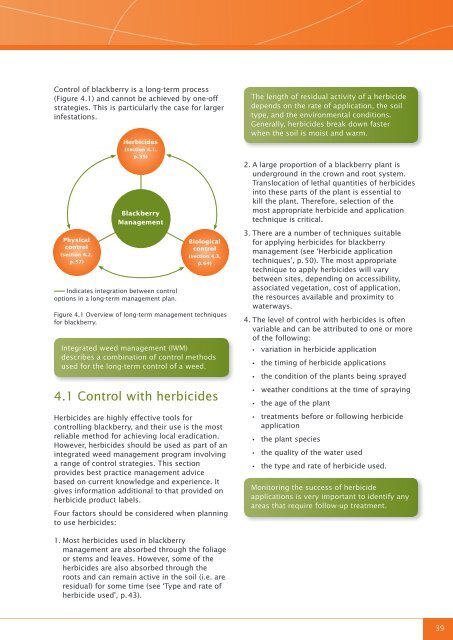Blackberry control manual - Weeds Australia
Blackberry control manual - Weeds Australia
Blackberry control manual - Weeds Australia
Create successful ePaper yourself
Turn your PDF publications into a flip-book with our unique Google optimized e-Paper software.
Control of blackberry is a long-term process<br />
(Figure 4.1) and cannot be achieved by one‐off<br />
strategies. This is particularly the case for larger<br />
infestations.<br />
Physical<br />
<strong>control</strong><br />
(section 4.2,<br />
p. 57)<br />
Herbicides<br />
(section 4.1,<br />
p. 39)<br />
<strong>Blackberry</strong><br />
Management<br />
Indicates integration between <strong>control</strong><br />
options in a long-term management plan.<br />
Biological<br />
<strong>control</strong><br />
(section 4.3,<br />
p. 64)<br />
Figure 4.1 Overview of long-term management techniques<br />
for blackberry.<br />
Integrated weed management (IWM)<br />
describes a combination of <strong>control</strong> methods<br />
used for the long-term <strong>control</strong> of a weed.<br />
4.1 Control with herbicides<br />
Herbicides are highly effective tools for<br />
<strong>control</strong>ling blackberry, and their use is the most<br />
reliable method for achieving local eradication.<br />
However, herbicides should be used as part of an<br />
integrated weed management program involving<br />
a range of <strong>control</strong> strategies. This section<br />
provides best practice management advice<br />
based on current knowledge and experience. It<br />
gives information additional to that provided on<br />
herbicide product labels.<br />
Four factors should be considered when planning<br />
to use herbicides:<br />
The length of residual activity of a herbicide<br />
depends on the rate of application, the soil<br />
type, and the environmental conditions.<br />
Generally, herbicides break down faster<br />
when the soil is moist and warm.<br />
2. A large proportion of a blackberry plant is<br />
underground in the crown and root system.<br />
Translocation of lethal quantities of herbicides<br />
into these parts of the plant is essential to<br />
kill the plant. Therefore, selection of the<br />
most appropriate herbicide and application<br />
technique is critical.<br />
3. There are a number of techniques suitable<br />
for applying herbicides for blackberry<br />
management (see ‘Herbicide application<br />
techniques’, p. 50). The most appropriate<br />
technique to apply herbicides will vary<br />
between sites, depending on accessibility,<br />
associated vegetation, cost of application,<br />
the resources available and proximity to<br />
waterways.<br />
4. The level of <strong>control</strong> with herbicides is often<br />
variable and can be attributed to one or more<br />
of the following:<br />
• variation in herbicide application<br />
• the timing of herbicide applications<br />
• the condition of the plants being sprayed<br />
• weather conditions at the time of spraying<br />
• the age of the plant<br />
• treatments before or following herbicide<br />
application<br />
• the plant species<br />
• the quality of the water used<br />
• the type and rate of herbicide used.<br />
Monitoring the success of herbicide<br />
applications is very important to identify any<br />
areas that require follow-up treatment.<br />
1. Most herbicides used in blackberry<br />
management are absorbed through the foliage<br />
or stems and leaves. However, some of the<br />
herbicides are also absorbed through the<br />
roots and can remain active in the soil (i.e. are<br />
residual) for some time (see ‘Type and rate of<br />
herbicide used’, p. 43).<br />
39

















